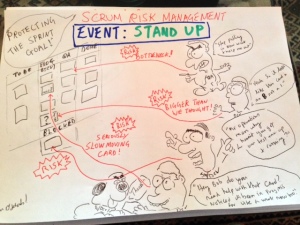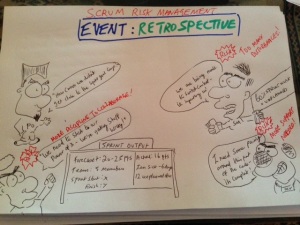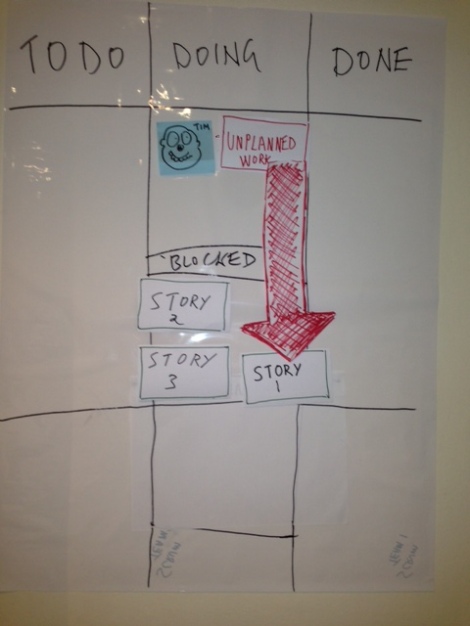The Product Owner is part of the Scrum team.
The stand up is an event for the Scrum team.
So why in the world would you not be pushing for your Product Owner to join the stand up?
Let me start with some of the most common responses I get from Scrum teams & ScrumMasters who can’t get their Product Owner to the stand up.
“He’s not in the country”
So? Heard of Link? Skype? Man, c’mon! This all comes down to desire. We as Scrum practitioners need to push and pull one another in the interest of doing great things! Yes off shore Product Owners are more challenging to get to the stand up, but that’s all it is – challenging. Not impossible. In one work place I was so determined we used to phone the PO up on my mobile & use it as the speaking token so he could hear each and every update on how we’re progressing, any risk which has surfaced and generally had his expectations managed in real time.
“The PO’s in an important meeting”
Is this meeting more important than the stuff you will be aiming to deliver in the sprint goal? Is it more important than an immediate decision he may need to make when he finds out that a story which was estimated as a 1 is now an 8 ? Does he want to lose that level of leverage? Nothing is more important than the Sprint goal to a true Product Owner. 10 minutes is a small but vital commitment to keep us inspecting and adapting on our progress to handle those inevitable unknowns that pop up.
“it’s ok we can update her later”
You sure can. And we can play chinese whispers as well, let’s tell a friend to tell a friend to tell friend! Seriously. Remember, the communication gap is one of the biggest challenges in software development.
We already as human beings misinterpret or get things wrong. I have seen this many, many times – a developer takes on the job of getting an update for the PO because the PO can’t or won’t make the stand up. The developer doesn’t cover something or put the context around that something – regardless- risk does not get mitigated, expectations do not get managed and the PO loses his or her ability to make decisions based on new learnings. All because not joining the stand up. Misinterpretations can’t be removed, let’s reduce the communication gap & drag the PO along 🙂
“Not much has changed anyway”.
Says who? All due respect. But the PO is representative of the business. The same way we in tech do not appreciate the business making assumptions about how ‘easy’ or ‘small’ a story is to implement – we need to equally show respect and not assume with what we regard as ‘not much changing’. Whilst at Deutsche bank a developer in one Scrum team found that she could not get a particular symbol added to one of the items in a drop down menu. Didn’t seem like a big deal, and so the PO only found out when we got to the Show & Tell. The outcome? We didn’t meet the MVP for the clients needs since this symbol impacted the ability of a particular financial instrument to work within the application. If something changes the PO needs to know. We don’t need to wait to the stand up to update the PO on the change – but it’s damn good place to start.
Yes but it’s not that simple, no one is listening to me!
Been there, done that, t-shirts, key rings, fridge magnets – the lot.
So which is it in your case? I mean, how did it come to your organisation moving towards Scrum – who did they pick or turn into the Product Owner?
Did they grab an expert user who has a million other things to do in their day job & told ’em “Hey you are our new Product Owner”. Or is it a new Director or some other ‘senior’ person that likes the idea of Scrum but doesn’t understand the commitment it needs for the PO role to work? Or was it someone they hired who has a different understanding to what a PO’s commitments to the Scrum are?
Look regardless of how it became the way it is, we CAN do something about it – and by the way – it doesn’t have to be only ScrumMasters ‘doing’ the something about it. As a Scrum team we are all responsible for inspecting & adapting towards our Sprint goal, the Scrum team together are more likely to get to that sprint goal – so show some courage and speak up.
Influencing the PO to join the stand up
Use team pressure – If the PO is still sitting at their desk when the team are about to do the stand up, you’d be surprised at how powerful it is when we all physically turn and look at the PO waiting for his/her to join us.
Lead by example – As a ScrumMaster one thing I do is emphasise the importance of acting the way you’d like your team members to act. “we want our guys to go above and beyond to deliver great product, man the least we can do is be there to be part of their update to ensure they feel supported, motivated & heard”
Show case misunderstandings – Did someone update the PO about something which effected a story being delivered? Capture that item, keep hold of it, build an damn archive if you must – and then present the metric back to the PO: “Yeah looks like we had a few spikes completed but we never fleshed out new stories since we weren’t sure that was the thing to do – could you come along to the stands up”
Press the Empowerment button – “Yeah so we found that we got x amount of traffic with this tech at y cost, and we decided to carry on with the story..it seemed worth it”. Like I said above, explain to the PO that we don’t want to take away his healthy power bar in making business decisions based on new findings. The PO might want to drop a story or get a new one thrown into the backlog based on new findings. Remind the PO that by not coming to the stand up, they lose power in their real time decision making which effects the learnings of the sprint.
Remind the PO of their importance – “Hey Mr PO you know when you come along to the stand up and you energise us talking about what great things this goal will bring, it really motivates the guys. Not to mention how they respect you as a peer turning up into the trenches as one of us ensuring that their clear on the deliverables”. Man there are so many examples of how I remind the PO of what great value they bring when they come to the stand up! Find the positives & sell ’em!
The Power of a coffee (or beer) – Stepping out with your PO out for a bite or drink allows you to create an informal and open conversation where we can be more candid with one another. Make the effort to lunch or whatever with your PO to make ’em feel like they are part of the team and want to be part of your team events.
IT’S NOT A PERFECT WORLD.
No it isn’t. But if we have good working relationships, speak openly about what we need and why then we are definitely iterating towards a better world.
The key is to keep it human and showcase the dysfunction we experience without the PO being at our stand up …help them understand the problem their absence can cause.
And don’t expect perfection, that ends up in disappointment.
Just because we can’t get the PO at every stand up, that doesn’t mean we should loose heart or get annoyed.
In Scrum we aim to deliver iterative small bite sized pieces of value, little and often.
That also applies to changing mindset.
Keep patient, keep human & showcase the problems to your PO.



















